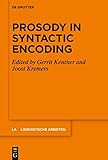Prosody in Syntactic Encoding / ed. by Gerrit Kentner, Joost Kremers.
Material type: TextSeries: Linguistische Arbeiten ; 573Publisher: Berlin ; Boston : De Gruyter, [2020]Copyright date: ©2020Description: 1 online resource (V, 334 p.)Content type:
TextSeries: Linguistische Arbeiten ; 573Publisher: Berlin ; Boston : De Gruyter, [2020]Copyright date: ©2020Description: 1 online resource (V, 334 p.)Content type: - 9783110649802
- 9783110651416
- 9783110650532
- 414.6 23/ger
- online - DeGruyter
- Issued also in print.
| Item type | Current library | Call number | URL | Status | Notes | Barcode | |
|---|---|---|---|---|---|---|---|
 eBook
eBook
|
Biblioteca "Angelicum" Pont. Univ. S.Tommaso d'Aquino Nuvola online | online - DeGruyter (Browse shelf(Opens below)) | Online access | Not for loan (Accesso limitato) | Accesso per gli utenti autorizzati / Access for authorized users | (dgr)9783110650532 |
Frontmatter -- Contents -- Prosody in syntactic encoding -- Sentence stress in presidential speeches -- German case ambiguities at the interface: Production and comprehension -- Ambiguity resolution via the syntax-prosody interface: The case of kya ‘what’ in Urdu/Hindi -- Focus structure affects comparatives: Experimental and corpus work -- The ordering of interface mapping rules in German object fronting -- Interaction at the syntax–prosody interface -- Syntacticizing intonation? Tag questions in Glasgow Scots -- A prosodic constraint on prenominal modification -- Cartography cannot express scrambling restrictions – but interface-driven relational approaches can -- Head movement as a syntax-phonology interface phenomenon -- Index
restricted access online access with authorization star
http://purl.org/coar/access_right/c_16ec
What is the role of prosody in the generation of sentence structure?A standard notion holds that prosody results from mapping a hierarchical syntactic structure onto a linear sequence of words. A radically different view conceives of certain intonational features as integral components of the syntactic structure. Yet another conception maintains that prosody and syntax are parallel systems that mutually constrain each other to yield surface sentential form.The different viewpoints reflect the various functions prosody may have: On the one hand, prosody is a signal to syntax, marking e.g. constituent boundaries. On the other hand, prosodic or intonational features convey meaning; the concept “intonational morpheme” (as e.g. an exponent of information structural notions like topic or focus) puts prosody and intonation squarely into the syntactic representation. The proposals collected in this book tackle the intricate relationship of syntax and prosody in the encoding of sentences. The contributions build their cases on the basis of solid empirical evidence, adducing data from experiments or from the careful analysis of natural speech. The volume thus represents a state of the art survey of research on the syntax-phonology interface.
Issued also in print.
Mode of access: Internet via World Wide Web.
In English.
Description based on online resource; title from PDF title page (publisher's Web site, viewed 25. Jun 2024)


